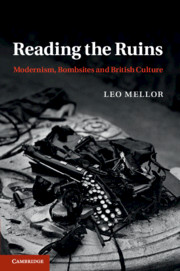Chapter 2 - A metropolis aflame
Published online by Cambridge University Press: 07 October 2011
Summary
Fire is so familiar, fire is everywhere to be seen. Fire needs no definition. This is one reason why it is so difficult to define. Its chemical definition is simple. The difficulty lies rather in the translation of fire into the imagination through such normally expedient channels as canvas and the written word.
William Sansom, ‘The Naked Flame’ (1942)This acute wariness felt by Sansom, as both a fireman and a short-story writer, about making art from a blazing city, provides a useful point of departure for considering fire, representation and London’s bombsites. A panoply of British writers in the Second World War who attempted to depict the infernos caused by incendiary bombing had the urge to incorporate, understand and feature fire in their works. But such an urge was also subject to real and intransigent debates: about what depiction might consist of, and about what moral shadows might be thrown by such an attempt. Sansom’s own works – especially the ‘fireman stories’ he wrote from 1941 onwards – show one possible form of guarded engagement. Yet writers across a spectrum of forms completed works that transformed the meanings of fire, and also exploited how and why fire could be transforming. There is a history both to such an aesthetic problem and to its remedies. Extremities of experience can be recounted, or turned into art, or at least forced – albeit with signs of struggle – within the expectations of established genres. The numerous Antarctic journals of explorers which resulted in the subgenre of the frozen sublime were one obvious exemplar; First World War memoirs, with their guarded indications of the phenomenon of the unrepresentable, another.
But there are some immediate and practical problems of writing ‘in’ or ‘of’ the Blitz, the conflagrations that accompanied the air attacks on London and other British cities throughout 1940–1. All the works considered in this chapter are those of aftermath, whether written in the immediate aftermath in terms of mere hours, or whether considered and shaped by the passage of months and years. The problem then ensues of the movement back and forth, between (relative) safety where composition was possible, and the depiction of a close-quarters encounter with an elemental, destructive and yet compulsively beautiful force. This means that the forms of these works are also shaped by awareness of time, memory and the problem of representation. Templates from various forms of modernist writing were available; those seeking an elemental corollary to the fashioning of art had choices ranging from fire as purgative to creative, and from D. H. Lawrence through to George Orwell – moreover the cliché ‘playing with fire’ could be, and was, applied to many strands of aesthetic engagement.
- Type
- Chapter
- Information
- Reading the RuinsModernism, Bombsites and British Culture, pp. 47 - 84Publisher: Cambridge University PressPrint publication year: 2011



